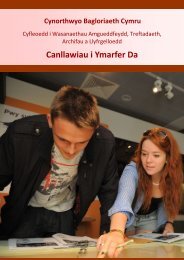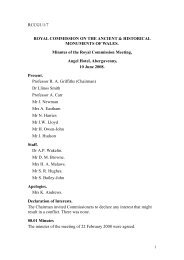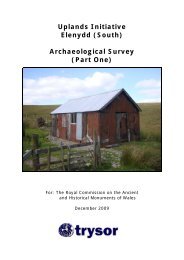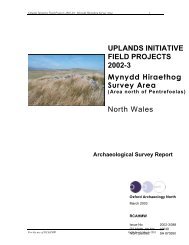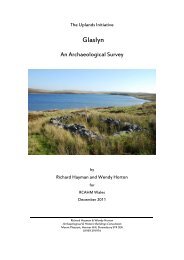Plynlimon (central) - Royal Commission on the Ancient and ...
Plynlimon (central) - Royal Commission on the Ancient and ...
Plynlimon (central) - Royal Commission on the Ancient and ...
You also want an ePaper? Increase the reach of your titles
YUMPU automatically turns print PDFs into web optimized ePapers that Google loves.
Upl<strong>and</strong>s Initiative – Nant y Moch & Pumlim<strong>on</strong> Fawr / <str<strong>on</strong>g>Plynlim<strong>on</strong></str<strong>on</strong>g> 2004l<strong>on</strong>g; <strong>the</strong>y were surrounded by a large st<strong>on</strong>e ring. A bic<strong>on</strong>ical grooved lugged food vessel of Irishtype was associated with <strong>the</strong> burial It is 6.7ins high, 8.2 ins at its widest, <strong>and</strong> preserved in <strong>the</strong>Nati<strong>on</strong>al Museum of Wales, Cardiff. Tumulus <strong>on</strong> Disgwylfa Fawr summit, at 1660 feet above OD.Now a turf covered mound, about 6feet high <strong>and</strong> 70 feet in diameter, apparently composed mainlyof fine, gravelly soil, though a few st<strong>on</strong>es are visible. It has been opened by a trench, refilled, from<strong>the</strong> south. C<strong>on</strong>diti<strong>on</strong> good. Examined by A.H.A.Hogg, 4/6/65. A turf-covered round barrow asdescribed above, 21.0m in diameter, 2.5m in height. There is a slight <str<strong>on</strong>g>central</str<strong>on</strong>g> depressi<strong>on</strong>, o<strong>the</strong>rwise<strong>the</strong> feature is in good c<strong>on</strong>diti<strong>on</strong>. No visible remains of a ditch. Cairn <strong>on</strong> unenclosed moorl<strong>and</strong>. Thelarge, turf-covered barrow is still as described, with a <str<strong>on</strong>g>central</str<strong>on</strong>g> hollow. A small st<strong>on</strong>e summit cairn ofpresumably recent date has been built <strong>on</strong> <strong>the</strong> W edge of <strong>the</strong> barrow. A quite well worn track from<strong>the</strong> west branches near <strong>the</strong> barrow <strong>and</strong> passes part <strong>on</strong> each side. There are comm<strong>and</strong>ing views in alldirecti<strong>on</strong>s (as far as I could tell in <strong>the</strong> mist!)‖(CADW listing 1988 - Cd 30). (For a more in depthdescripti<strong>on</strong> of <strong>the</strong> findings see <strong>the</strong> article in Antiquity Journal 1939; BBCS 1938)With regards known st<strong>and</strong>ing st<strong>on</strong>es in <strong>the</strong> area <strong>the</strong>re are surprisingly few, <strong>on</strong>ly 7 in total. There is ast<strong>and</strong>ing pair (NPRN: 301687), locally known as <strong>the</strong> ‗Bwlch a‘r Llo‘ or ‗Cow <strong>and</strong> Calf‘, at <strong>the</strong> far west endof <strong>the</strong> survey area near Esgair Gorlan (Area 5). The largest st<strong>on</strong>e is approx. 2m in height x 1.25m girth. Thesmaller st<strong>on</strong>e is approx. 4m fur<strong>the</strong>r east, <strong>and</strong> is approx. 1.25m in height x 1.25m in girth. There are nomarkings evident <strong>on</strong> ei<strong>the</strong>r of <strong>the</strong>se st<strong>on</strong>es. The l<strong>and</strong>scape here is tall grass <strong>and</strong> marsh l<strong>and</strong>. A fur<strong>the</strong>rst<strong>and</strong>ing, similar in form to this pair, is also located 100m to <strong>the</strong> west, although this st<strong>on</strong>e is outside of <strong>the</strong>survey area. However approx. 800m to <strong>the</strong> east is a small white quartz boulder (Area 4) which has beendescribed in <strong>the</strong> past as being a st<strong>and</strong>ing st<strong>on</strong>e (NPRN: 282137). A fur<strong>the</strong>r pair of st<strong>and</strong>ing st<strong>on</strong>es (NPRN:284077), are to be found <strong>on</strong> <strong>the</strong> hill above <strong>the</strong> Llywernog Lead Mine museum (Area 6). This st<strong>on</strong>e pair areeach approx. 0.50m high x 0.50m wide. They are set approx. 3m apart <strong>and</strong> orientated NW-SE. They arelocated <strong>on</strong> a rising slope <strong>on</strong>ly approx. 20m from a p<strong>on</strong>ded area. In <strong>the</strong> area known as Garn Lwyd, in <strong>the</strong>ritual l<strong>and</strong>scape close to Hirnant (Area 7), is a small st<strong>and</strong>ing st<strong>on</strong>e at <strong>the</strong> base of a rock outcrop (NPRN:303683). This st<strong>and</strong>ing st<strong>on</strong>e is reportedly approx. 1.10m high with a girth of approx. 3 ft. However, at <strong>the</strong>time of <strong>the</strong> field visit a st<strong>and</strong>ing st<strong>on</strong>e <strong>on</strong>ly approx. 0.60m high with a girth of approx. 0.30m was observedat <strong>the</strong> given locati<strong>on</strong>. The last st<strong>and</strong>ing st<strong>on</strong>e in <strong>the</strong> area is located in <strong>the</strong> area of ‗Fainc Ddu‘ (Area 8)known in <strong>the</strong> archive records as Pen Cor-maen st<strong>and</strong>ing st<strong>on</strong>e (NPRN: 303680). Although marked <strong>on</strong> <strong>the</strong>modern Ordnance Survey map at <strong>the</strong> time of <strong>the</strong> field visit no st<strong>and</strong>ing st<strong>on</strong>e was found at <strong>the</strong> givenlocati<strong>on</strong>. It is presumed that this st<strong>on</strong>e has ei<strong>the</strong>r been moved or destroyed or else <strong>the</strong> grid reference given iswr<strong>on</strong>g.O<strong>the</strong>r than <strong>the</strong>se few Br<strong>on</strong>ze Age sites <strong>the</strong> <strong>on</strong>ly o<strong>the</strong>r evidence for Br<strong>on</strong>ze Age activity is in <strong>the</strong> form offind-spots. These include a br<strong>on</strong>ze age socket-looped spearhead found in <strong>the</strong> 1930s (NPRN: 284255) found<strong>on</strong> <strong>the</strong> south-west upper slope of Pumlim<strong>on</strong> Fawr, <strong>and</strong> a fur<strong>the</strong>r br<strong>on</strong>ze age object, for which <strong>the</strong>re is noinformati<strong>on</strong> readily available within <strong>the</strong> archive, found close to <strong>the</strong> summit of Pen Pumlim<strong>on</strong> Arwystli(NPRN: 284072). It is very likely that both of <strong>the</strong>se finds were originally found within <strong>the</strong> cairns atop bothof <strong>the</strong>se summits <strong>and</strong> <strong>the</strong>n later discarded.With regards <strong>the</strong> Ir<strong>on</strong> Age period, <strong>the</strong>re are two known Ir<strong>on</strong> Age sites within <strong>the</strong> survey area, both of <strong>the</strong>seare Ir<strong>on</strong> Age hill fort remains. The first of <strong>the</strong>se is located <strong>on</strong> top of <strong>the</strong> small rocky hill known as ‗Dinas‘ or‗Fort‘ (NPRN: 303697). The following descripti<strong>on</strong> of Dinas hillfort has been extracted from <strong>the</strong> CadwScheduled M<strong>on</strong>ument listing descripti<strong>on</strong>;―The top of an isolated hill reaching 1262 feet above sea level is crowned by an enclosure. Theel<strong>on</strong>gated oval is determined by <strong>the</strong> ground, which falls precipitously with sheer rock outcropsal<strong>on</strong>g <strong>the</strong> l<strong>on</strong>ger sides. The enclosure appears to be st<strong>on</strong>e built with material from an inner spoilditch which can be traced irregularly <strong>on</strong> all sides. There is no apparent ditch. The entrance, a simplegap, is <strong>on</strong> <strong>the</strong> north side. Open moor. A small early Ir<strong>on</strong> Age univallate hill fort, <strong>the</strong> bank havingbeen formed from <strong>the</strong> large internal quarry ditch; <strong>the</strong>re is no outer ditch. There is <strong>on</strong>e hut platformnear <strong>the</strong> centre of <strong>the</strong> enclosure <strong>and</strong> possibly three o<strong>the</strong>rs. One exists <strong>on</strong> <strong>the</strong> hillside 450 yards to<strong>the</strong> south (SN 78 SW 21). 'Dinas', an IA univallate hilltop settlement or fort, at 1250 feet above sealevel,occupying <strong>the</strong> summit of an isolated hill, with very steep natural slopes <strong>on</strong> all but <strong>the</strong> southside. The work measures internally, 112.0m north-south, by 54.0m transversely. The rampartaverages 6.0m in width, <strong>and</strong> 0.5m in height internally, but is up to 2.0m high externally. Precipitous71CAP Report No: 355


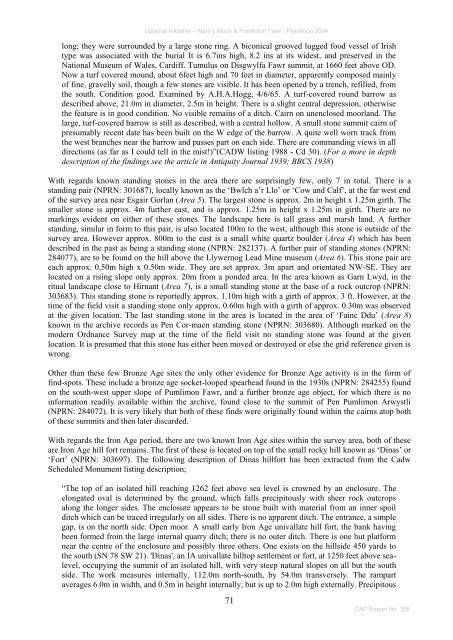

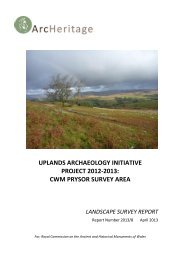
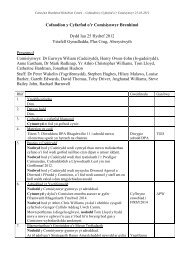
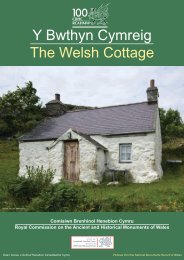

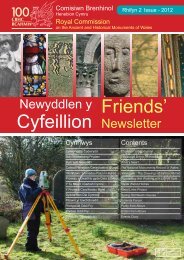
![The Source of the Usk Walk [2012 PDF]](https://img.yumpu.com/49285699/1/190x245/the-source-of-the-usk-walk-2012-pdf.jpg?quality=85)

